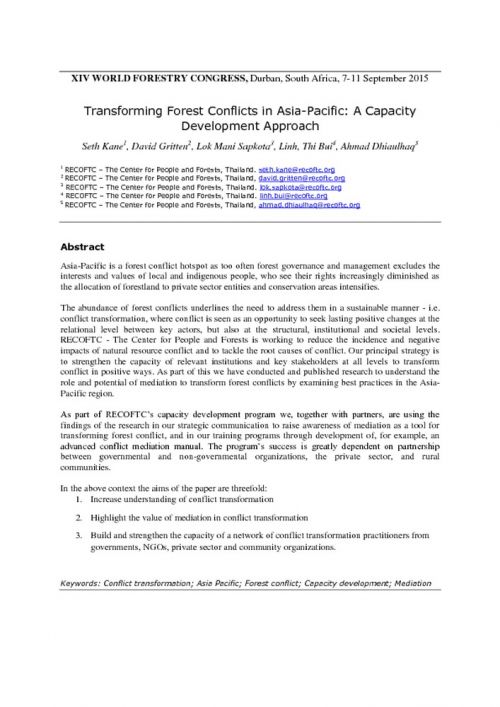APA 6th ed. Transforming Forest Conflicts in Asia-Pacific: A Capacity Development Approach. (2015, August 1). Retrieved from https://www.recoftc.org/publications/0000203
MLA 8th ed. Transforming Forest Conflicts in Asia-Pacific: A Capacity Development Approach. RECOFTC, 1 August 2015, https://www.recoftc.org/publications/0000203.
Chicago 17th ed. RECOFTC. 2015. "Transforming Forest Conflicts in Asia-Pacific: A Capacity Development Approach." Published August 1, 2015. https://www.recoftc.org/publications/0000203.
Transforming Forest Conflicts in Asia-Pacific: A Capacity Development Approach

Asia-Pacific is a forest conflict hotspot as too often forest governance and management excludes the interests and values of local and indigenous people, who see their rights increasingly diminished as the allocation of forestland to private sector entities and conservation areas intensifies.
The abundance of forest conflicts underlines the need to address them in a sustainable manner – i.e. conflict transformation, where conflict is seen as an opportunity to seek lasting positive changes at the relational level between key actors, but also at the structural, institutional and societal levels. RECOFTC – The Center for People and Forests is working to reduce the incidence and negative impacts of natural resource conflict and to tackle the root causes of conflict. Our principal strategy is to strengthen the capacity of relevant institutions and key stakeholders at all levels to transform conflict in positive ways. As part of this we have conducted and published research to understand the role and potential of mediation to transform forest conflicts by examining best practices in the AsiaPacific region.
As part of RECOFTC’s capacity development program we, together with partners, are using the findings of the research in our strategic communication to raise awareness of mediation as a tool for transforming forest conflict, and in our training programs through development of, for example, an advanced conflict mediation manual. The program’s success is greatly dependent on partnership between governmental and non-governmental organizations, the private sector, and rural communities.

